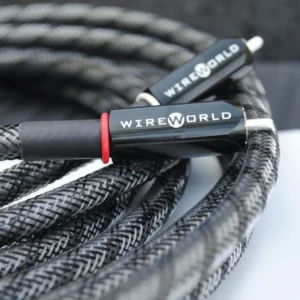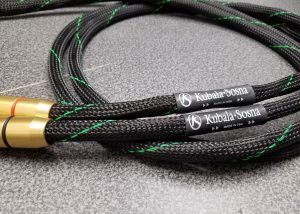At the turn of the twentieth century, Igor Stravinsky rocked the classical firmament with scores such as Song of the Nightingale. One hundred years later, the work is still so fresh as to pull you up short, mouth agape, wondering, "Where did that come from?"
I always go back to the Fritz Reiner / Chicago Symphony Orchestra Golden Age RCA recording from 1959. And this evening I cued it on a SACD reissue from Analogue Productions (CAPC 2150 SA). Then I did the audiophile shuffle to the reissue LP, also by Analogue Productions (AAPC 2150).
Both reissues sound great but, of course, they are different. The reissue LP beats both the SACD and the original LP in my rig. (That's been true for a while with AP reissues, I imagine it's wreaking havoc with the original pressings market.) I reminded Lynn there was a length of the newly arrived Audience frontRow interconnect between the DAC and preamp. "Is that why the LP has no bass?" she inquired.
Yeah, I couldn't deny it. I thought the LP low-end was good—until this cable came along. The frontRow allocates more to it and sends it down deep. Jazz aficionados will really dig the way upright bass solos are rendered with outstanding pitch accuracy. But there's a lot more to say, because the way it is implemented is key to the cable's voicing.
frontRow powerChords
Could More Sound Like Less?
If your taste runs to classical chamber music, you might come to the opposite conclusion, as far as quantity of low-end. How is it possible that more could sound like less? This oddity came to my attention when I reviewed the sibling frontRow powerChord. I found it hard to get a lock on the cables' tonal balance:
With a chamber music piece like the Brahms String Sextet Opus 36, the lovely, midrange-centric playback caused me to think, "Where's da bass?" But as soon as I swapped in an orchestral CD, like the Beethoven Romance No. 2 for violin and orchestra, the full frequency deck rolled out including punchy, tuneful bass that caught my ear and brought a smile.
The powerChord bass was a changeling, showing me different faces depending what was in the CD drawer. In classical chamber music, deep bass is an occasional thing: there isn't much low register contribution in the cello part of the Brahms String Sextet. The frontRow powerChord was presenting the source material accurately—and that pulled me up short. The interconnect closely follows suit.
I confess I didn't know what to make of this "have more but sound like less." I didn't understand where it was coming from until I began to think about how bass is reproduced in a recording studio. It has little to do with quantity. It is about control and accuracy, reigning it in and preventing it from spilling over and exciting adjacent frequencies (a common coloration of the "musical" cables). The frontRow interconnect has outstanding bass grip that locked tightly to the signal. (This applies from top to bottom, but it is most pronounced in the bass.) Once seen in this light, I began to appreciate what an achievement we have here.
Let Me Recap So Far
My system is voiced for frequency integration and time coherency, without skimping on bloom and ambiance. We certainly enjoy high-res, but 3-D imaging and high contrast details take a back seat. Music should be alive and incisive, however the listener should not be assaulted or made to feel uncomfortable. This is the sound of the reference wire that we've lived with for years. It certainly has its charms.
A Bare Nekkid Soundstage
Swapping in the frontRow interconnect (or powerChord) upset that idyll. In a snap, the edges sharpened, much of the ambiance was blown away, and something like clear-sightedness prevailed. Hall cues and reverb was shaved—where'd all the atmosphere go? Now I occasionally notice room cues at the end of a phrase. Obscure low-level information, like vibrato on sustained notes, often appears in places it hadn't been before. The frontRow wires left the images almost indecently exposed. Shouldn't there be more bloom?
This presentation was dramatically different—but was it better? My current wires generally put me in the concert hall. The frontRow puts the engineering team in the driver's seat—you'll be in the concert hall if they captured that in the recording. I can tell you, if you've never experienced it, this is extremely eye-opening. You'll hear things you haven't before, in correct proportion and perspective to each other, and know that it's right. But the question stands: do you want to recreate a recording studio or a concert hall in your sound room? There are partisans on either side. The answer is, it depends on what you're after.
For me, if all the frontRow offered was extreme honesty, I would pass. What swayed me was to discover a bevy of attractive, musical attributes in the cables' voicing. Let me elaborate some of these credentials.
The Musical Graces
For the audiophile consumer, one of the first purchase considerations is, can the product elicit the "fool ya" response and make you think, "Could it be live?" I have a sure-fire test. All day long street noise intermittently penetrates my apartment in NYC. Sitting in the sweet spot, if the outside noise sounds like it may be inside—if I can't tell where it's coming from—that tells me the wire I'm evaluating has realistic tone. The frontRow gave me plenty of these "fool ya" moments.
Some cables are dark; some have no bass; others are strident. In my opinion, most are too light. The tone of the frontRow was somewhat hard to pin down but, generally, it was appropriate for the program material. And it didn't require fussing to get great sound. That's key: if surgery is needed, pack it up and send it on its way.
A second consideration is tonal saturation or density. The images need to be made of flesh and blood and should appear healthy; avoid the extreme body types, i.e., anorexic or obese. The frontRow images are large, with lots of firm body mass. Plus, it's a little on the warm side in tonal temperature.
Timbre Discussion
For the classical music lover, the next ingredient is critical. Classical musicians are judged on their technique, interpretation, and beauty of sound. That's what I want to hear in my soundroom. Let me tell you, audio gear capable of this is not easy to find! There are only a few members in the cable (let alone component) Timbre Champ Club and they tend to be quite costly.
To be invited to the club, the wire must pass the complete structure of the note, without losing pieces en route. Anything less, they start to loose their uniqueness and the degree of sameness increases. Anything less, each deficit compromises the natural beauty of the sound. Your brain automatically kicks in to discover the deficit and figure out which instrument is playing.
It is with unabashed delight to report the Audience frontRow interconnect met the requirements for uniqueness and beauty. It's as if your box of 24 color crayons was swapped for one with 64 sticks. While I cannot say it's the best I've heard (those guys have something like 128 sticks), the frontRow gets invited to the club, with the distinction of being the most affordable member.
Cosmetics and Design
A word about cosmetics. In this era of the supersized, it comes as a shock to encounter top-performing, high-quality interconnect cables as user-friendly as these frontRow ones. I actually chuckled when I opened the box with the RCA IC. It is much thinner than any of the top-drawer RCA interconnects in my library, about the same diameter as the Audioquest Diamond, and is flexible like the Audio Note silver wire. Ultra-thin wires have long been a point of pride for Audience.
frontRow RCA & XLR
You can say the same about the XLR version, although it is not nearly as thin or as flexible as the frontRow RCAs (but still way thinner than my other XLR ICs). Build quality of both is excellent. Cosmetically, they have matching color schemes with a black woven fabric outer sheath.
frontRow Interconnect Internals
The similarity ends with the cosmetics: internally, a balanced signal mandates a wholly different design from a single-ended one.
A pair of the RCA interconnects is "engineered with 2 x frontRow 24 strand, plus 2 x frontRow 90 strand 99.999% Pure OCC conductors in Audience Double Cylindrical Perfect Lay geometry." The RCA plugs are Audience Rhodium Plated Carbon Fiber Solder-less RCA. They fit snug and secure.
The XLR cable pair is "engineered with 4 x frontRow 29 strand, 99.999% Pure OCC conductors in a shielded twin axial geometry." The connectors are Audience Gold plated Tellurium and Carbon Fiber.
You can see that about the only thing they have in common is the Pure OCC conductors. This suggests they might sound different. I compared the two in the link between my DAC and preamp in my fully balanced CH Precision system. The XLR was stronger across the board. Where the RCA was soft and smooth, the XLR had more depth of tone, texture, and made bigger crescendos. (Results will differ with single-ended components. I asked my buddy George at Nirvana Sound about it, who said customers with gear that uses S-E or unbalanced circuitry like Ypsilon, WAVAC, or darTZeel virtually all prefer the RCA.)
the MORRE Package
The frontRow series, the latest from the design team at Audience, incorporates a long list of new technology under the covers, which is bundled under the umbrella acronym MORRE (Musically Optimized Reduction of Resistive Energy).
Click here to read a white paper about MORRE.
Conclusion
Time doesn't stand still in high tech or its trickle-down consumer progeny. It behooves the serious audiophile to test the waters at an accelerated pace these days. They tell me I review more audio wires than most, but I had grown complacent. I hadn't met any lately that jumped up and grabbed me. Things changed abruptly, however, when I recently took a dip in the power cable pool and came back with three stunning specimens.
A friend recommended the Audience frontRow line and their powerChord was the first cable to come in. Several have since taken up residence in the reference system. What a pleasant surprise that was!
That encouraged me to push ahead with the frontRow interconnects, and now I'm really smitten—it is even better than the powerChord! The level of performance came as a shock. There's no escaping it: in my balanced system, the frontRow XLR interconnect is knocking on the door of the top tier and demands entry. (I'm told the RCA is equally good in a single-ended system.) Individual cables of what I consider the elite club may offer better performance in this or that area but, taken as a package, you are not stepping down a rung with the frontRow. And the elite generally cost at least twice as much.
The frontRow interconnect will not be going back anytime soon. Next stop will be the frontRow speaker cables. You should jump on the train before it pulls out of the station.
frontRow RCA Interconnect
Retail: $3300/m
frontRow XLR Interconnect
Retail: $3800/m
Audience AV

















































